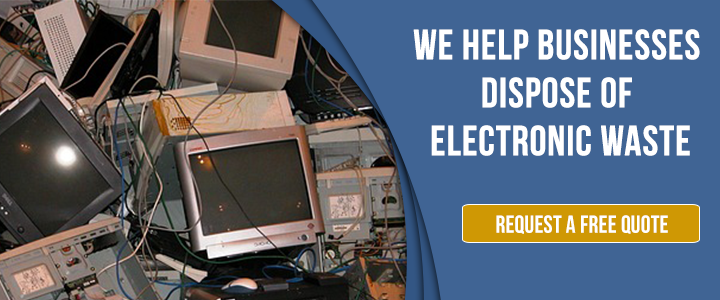Like paper and pens, electronics are used in nearly every business environment, no matter the size of your company. When electronics reach the end of their lifespan, however, discarding them isn’t as simple as tossing them into the trash.
To avoid steep fines and big headaches, properly disposing of unwanted electronics is important … not only to avoid harming the environment, but to ensure you don’t break any electronic waste disposal laws.
Here are some do’s and don’ts of how to recycle electronic waste so that next time your company has to toss computers, circuit boards or even appliances, you can make sure your liability and reputation don’t get tossed into the trash with them.
DO Know Your State Laws
 Here’s why this is especially important: What constitutes e-waste legally and how it must be disposed of differs among states and the federal government.
Here’s why this is especially important: What constitutes e-waste legally and how it must be disposed of differs among states and the federal government.
At the federal level, there are no laws on the recycling of electronic products, except for the management of cathode ray tubes (CRTs). CRTs are found in computer monitors and the federal Resource Conservation and Recovery Act (RCRA) classifies these as hazardous waste.
Every other type of electronic waste is managed at the state or local level. In fact, 25 states have put into place electronics recycling laws, including California. California e-waste laws are more rigorous than most other states’ laws because they:
- Include specific definitions of what types of e-waste must be regulated
- Focus on battery recycling
- Take CRT recycling an extra step by allowing scrap CRT panel glass to be used in new products
- Require retailers to accept cell phones from consumers and businesses for the purpose of recycling them
Simply going by what regulations the federal government imposes, or even by what one state requires over another, can leave your business in hot water.
DON’T Be Limited By Traditional Definitions
When you read the term, “electronic waste,” you may think computer monitors, televisions, radios, keyboards and other items commonly found in office settings.
However, there are many types of e-waste found in a variety of business settings, from small and large appliances to circuit boards and lamps.
Individuals and businesses in the United States toss more than 9 million tons of electronics every year, and only 12.5% of e-waste is recycled. Knowing what constitutes e-waste can help you as a business owner or manager better develop a waste management plan or more complete Hazardous Materials Business Plan.
Examples of e-waste include:
- Televisions
- Computer monitors and towers
- Flashlights
- CD players, DVD players and VCRs
- Printers
- Keyboards
- Calculators
- Lamps
- Circuit boards
- Power supply units
- Servers
- Tablets
- Mobile phones
- Photocopiers
- Electronic tools
Even laboratory equipment like hot plates, microscopes and calorimeters can qualify as e-waste.
DO Know What Is Safe And Unsafe To Dispose Of In A Trash Bin
 Not every component of an electronic needs to be recycled. A large number of substances commonly found in electronic devices are completely harmless.
Not every component of an electronic needs to be recycled. A large number of substances commonly found in electronic devices are completely harmless.
For example, common materials found in electronics that are considered safe include:
- Zinc plating, often found in steel production parts
- Aluminum, found in most electronics
- Copper and gold, regularly used in computer parts
- Plastic and glass, not including CRT panel glass
However, there are many materials NOT considered safe, which is why the recycling of electronics is required in California. Substances that pose dangers to humans and animals include:
- Sulfur, found in certain types of batteries
- Mercury, found in light bulbs and computer monitors
- Beryllium oxide, found in computer towers
- Other heavy metals, such as cadmium, chromium and lead
Because one piece of equipment may include both safe and unsafe components, it’s important to keep the next tip in mind.
DON’T Try To Separate Materials
It can be difficult to know what is considered e-waste versus what can be discarded in the trash. Even if you are able to differentiate between safe and unsafe materials in one piece of equipment, trying to separate these non-hazardous and hazardous materials from each other can be dangerous.
For example, while aluminum, often found in most electronics, is not hazardous, mercury (found in computer monitors) is extremely hazardous and can cause serious health issues such as respiratory and skin disorders.
Only professionals with proper training in e-waste disposal should separate materials. A certified electronic waste disposal company can also help you determine which electronics you have on-site should be recycled.
Do Rely On the Experts
Helping you determine whether your electronics are considered hazardous waste or non-hazardous waste is just one benefit experienced waste disposal companies can offer.
While the state of California has several drop-off facilities where you can dispose of your e-waste, you may run into several issues.
For example, not all drop-off facilities accept all types of e-waste. For example, while one may accept appliances, it may not accept computer monitors. Many drop-off facilities also have quantity limits, requiring your company to make several trips to different facilities.
You may have a difficult time finding a facility that accepts spent batteries or mercury-containing thermostats, since these are not common materials that drop-off facilities accept.
A certified e-waste disposal company can ensure ALL of your electronic waste gets disposed of safely and quickly. Considering disposal can be a time-consuming process, the best disposal companies will respond to your needs in a timely manner so you can move forward with running your business.


Comment